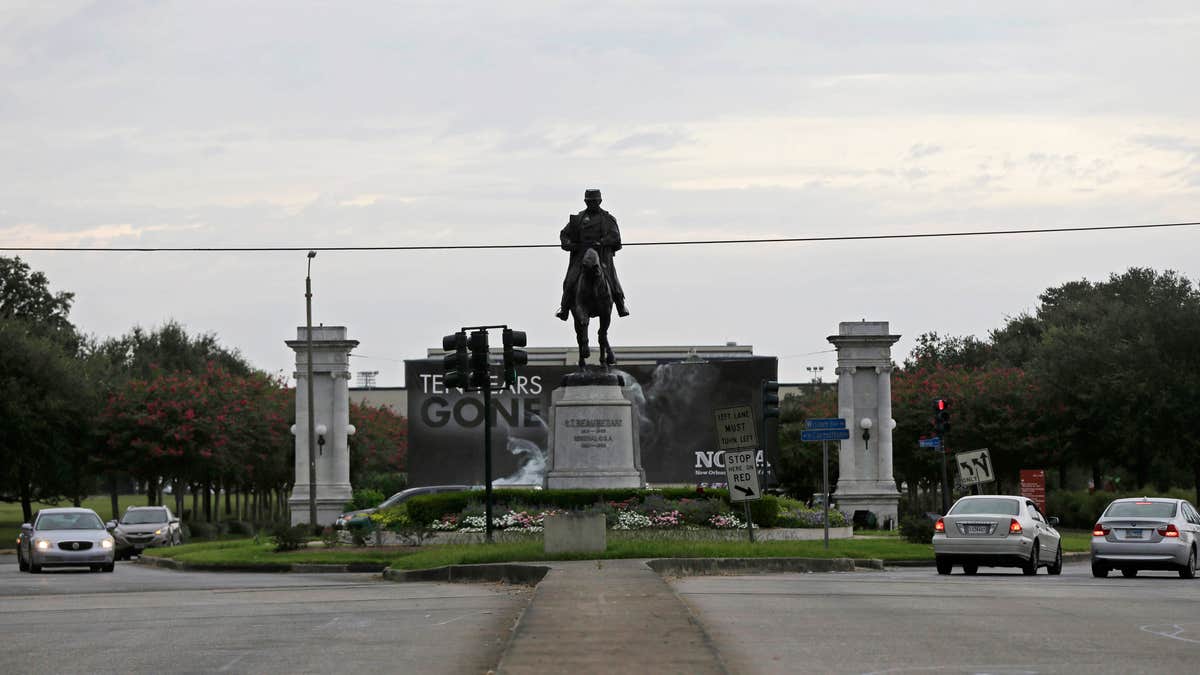
In this Sept. 2, 2015 photo, a statue of P.G.T. Beauregard is seen at the entrance to City Park at Esplanade Ave. in New Orleans. (AP)
Four prominent Confederate monuments in New Orleans were slated for removal Thursday, ending a months-long process that began in the aftermath of the killing of nine African Methodist Church members in Charleston, S.C., by a white supremacist last June.
Mayor Mitch Landrieu, a Democrat, approved the removal by signing legislation only hours after the city council voted 6-1 in favor of the move. In order for New Orleans to move forward, "we must reckon with our past," Landrieu told the council ahead of the vote.
The new law takes aim at statuary memorializing three prominent Confederate figures: Confederate President Jefferson Davis, General Robert E. Lee, and General P.G.T. Beauregard, a Louisiana native.
The fourth monument honors the former Crescent City White League, a chapter of a white supremacist paramilitary organization active in the 1870's.
The removal of that monument is subject to a federal court order. The city will now take the legal steps needed for that to happen.
Landrieu said the process to remove three of the monuments will begin within days by finding a contractor to take them down. He said it will cost about $170,000 to remove them. The city previously has said an anonymous donor has offered to pay for the work, according to the Associated Press.
He first proposed taking down these monuments after a white supremacist allegedly killed nine parishioners inside the Emanuel AME Church in Charleston, South Carolina, in June.
Anti-Confederate sentiment has grown since then around the country, along with protests against police mistreatment, as embodied by the Black Lives Matter movement.
The most imposing of the monuments to be struck from the cityscape under the new law has had a commanding position over St. Charles Avenue since 1884: A 16-foot-tall bronze statue of Confederate General Robert E. Lee stands atop a 60-foot-high Doric marble column, which itself rises over granite slabs on an earthen mound. Four sets of stone staircases, aligned with the major compass points, ascend the mound.
Above it all, the Virginian stands in his military uniform, with his arms folded and his gaze set firmly on the North.
A bronze figure of Confederate President Jefferson Davis that now stands at Canal Street and Jefferson Davis Parkway will be removed, along with a statue of a more local hero, Pierre Gustave Toutant Beauregard, who straddles a prancing horse at the entrance to City Park. Gen. P.G.T. Beauregard was born in St. Bernard Parish, and commanded Confederate forces in the war's first battle.
The most controversial monument is an 1891 obelisk honoring the Crescent City White League. An inscription added in 1932 said the Yankees withdrew federal troops and "recognized white supremacy in the South" after the group challenged Louisiana's biracial government after the Civil War.
In 1993, these words were covered by a granite slab with a new inscription, saying the obelisk honors "Americans on both sides" who died and that the conflict "should teach us lessons for the future."
The city says it plans to put the monuments in a warehouse until officials decide where they should be put in the future -- perhaps in a museum or a park.
Landrieu said the monuments reinforce the Confederate ideology of slavery, limit city progress and divide the city. He used President Abraham Lincoln's famous quote: "A house divided against itself cannot stand."
City Council President Jason Williams called the vote a symbolic severing of an "umbilical cord" tying the city to the offensive legacy of the Confederacy and the era of Jim Crow laws.
"If anybody wins here, it will be the South, because it is finally rising," Williams, who is African-American, said.
Stacy Head, a council member at large, was the lone vote against the removal. She is one of two white council members.
She lamented what she called a rush to take the monuments down without adequate consideration of their historic value and meaning to many in New Orleans.
Fixing historic injustice is "a lot harder work than removing monuments," she said, even as many in the packed council chambers jeered her.
She said the issue was dividing the city, not uniting it. "I think all we will be left with is pain and division."
The decision came after months of impassioned debate. Now, the city faces possible lawsuits seeking to keep the monuments where they are.
The Associated Press contributed to this report.

